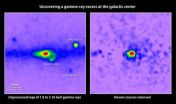(Press-News.org) VIDEO:
This animation zooms into an image of the Milky Way, shown in visible light, and superimposes a gamma-ray map of the galactic center from NASA's Fermi. Raw data transitions to...
Click here for more information.
A new study of gamma-ray light from the center of our galaxy makes the strongest case to date that some of this emission may arise from dark matter, an unknown substance making up most of the material universe. Using publicly available data from NASA's Fermi Gamma-ray Space Telescope, independent scientists at the Fermi National Accelerator Laboratory (Fermilab), the Harvard-Smithsonian Center for Astrophysics (CfA), the Massachusetts Institute of Technology (MIT) and the University of Chicago have developed new maps showing that the galactic center produces more high-energy gamma rays than can be explained by known sources and that this excess emission is consistent with some forms of dark matter.
"The new maps allow us to analyze the excess and test whether more conventional explanations, such as the presence of undiscovered pulsars or cosmic-ray collisions on gas clouds, can account for it," said Dan Hooper, an astrophysicist at Fermilab in Batavia, Ill., and a lead author of the study. "The signal we find cannot be explained by currently proposed alternatives and is in close agreement with the predictions of very simple dark matter models."
The galactic center teems with gamma-ray sources, from interacting binary systems and isolated pulsars to supernova remnants and particles colliding with interstellar gas. It's also where astronomers expect to find the galaxy's highest density of dark matter, which only affects normal matter and radiation through its gravity. Large amounts of dark matter attract normal matter, forming a foundation upon which visible structures, like galaxies, are built.
No one knows the true nature of dark matter, but WIMPs, or Weakly Interacting Massive Particles, represent a leading class of candidates. Theorists have envisioned a wide range of WIMP types, some of which may either mutually annihilate or produce an intermediate, quickly decaying particle when they collide. Both of these pathways end with the production of gamma rays -- the most energetic form of light -- at energies within the detection range of Fermi's Large Area Telescope (LAT).
When astronomers carefully subtract all known gamma-ray sources from LAT observations of the galactic center, a patch of leftover emission remains. This excess appears most prominent at energies between 1 and 3 billion electron volts (GeV) -- roughly a billion times greater than that of visible light -- and extends outward at least 5,000 light-years from the galactic center.
Hooper and his colleagues conclude that annihilations of dark matter particles with a mass between 31 and 40 GeV provide a remarkable fit for the excess based on its gamma-ray spectrum, its symmetry around the galactic center, and its overall brightness. Writing in a paper submitted to the journal Physical Review D, the researchers say that these features are difficult to reconcile with other explanations proposed so far, although they note that plausible alternatives not requiring dark matter may yet materialize.
"Dark matter in this mass range can be probed by direct detection and by the Large Hadron Collider (LHC), so if this is dark matter, we're already learning about its interactions from the lack of detection so far," said co-author Tracy Slatyer, a theoretical physicist at MIT in Cambridge, Mass. "This is a very exciting signal, and while the case is not yet closed, in the future we might well look back and say this was where we saw dark matter annihilation for the first time."
The researchers caution that it will take multiple sightings – in other astronomical objects, the LHC or in some of the direct-detection experiments now being conducted around the world -- to validate their dark matter interpretation.
"Our case is very much a process-of-elimination argument. We made a list, scratched off things that didn't work, and ended up with dark matter," said co-author Douglas Finkbeiner, a professor of astronomy and physics at the CfA, also in Cambridge.
"This study is an example of innovative techniques applied to Fermi data by the science community," said Peter Michelson, a professor of physics at Stanford University in California and the LAT principal investigator. "The Fermi LAT Collaboration continues to examine the extraordinarily complex central region of the galaxy, but until this study is complete we can neither confirm nor refute this interesting analysis."
While the great amount of dark matter expected at the galactic center should produce a strong signal, competition from many other gamma-ray sources complicates any case for a detection. But turning the problem on its head provides another way to attack it. Instead of looking at the largest nearby collection of dark matter, look where the signal has fewer challenges.
Dwarf galaxies orbiting the Milky Way lack other types of gamma-ray emitters and contain large amounts of dark matter for their size – in fact, they're the most dark-matter-dominated sources known. But there's a tradeoff. Because they lie much farther away and contain much less total dark matter than the center of the Milky Way, dwarf galaxies produce a much weaker signal and require many years of observations to establish a secure detection.
For the past four years, the LAT team has been searching dwarf galaxies for hints of dark matter. The published results of these studies have set stringent limits on the mass ranges and interaction rates for many proposed WIMPs, even eliminating some models. In the study's most recent results, published in Physical Review D on Feb. 11, the Fermi team took note of a small but provocative gamma-ray excess.
"There's about a one-in-12 chance that what we're seeing in the dwarf galaxies is not even a signal at all, just a fluctuation in the gamma-ray background," explained Elliott Bloom, a member of the LAT Collaboration at the Kavli Institute for Particle Astrophysics and Cosmology, jointly located at the SLAC National Accelerator Laboratory and Stanford University. If it's real, the signal should grow stronger as Fermi acquires additional years of observations and as wide-field astronomical surveys discover new dwarfs. "If we ultimately see a significant signal," he added, "it could be a very strong confirmation of the dark matter signal claimed in the galactic center."
INFORMATION: END
Fermi data tantalize with new clues to dark matter
2014-04-03
ELSE PRESS RELEASES FROM THIS DATE:
Which couples who meet on social networking sites are most likely to marry?
2014-04-03
New Rochelle, NY, April 3, 2014—Nearly 7% of Americans married between 2005-2012 met on social networking sites. How those couples compare to couples who met through other types of online meetings or the "old-fashioned" way in terms of age, race, frequency of Internet use, and other factors is explored in an article in Cyberpsychology, Behavior, and Social Networking, a peer-reviewed journal from Mary Ann Liebert, Inc., publishers. The article is available free on the Cyberpsychology, Behavior, and Social Networking website.
In "First Comes Social Networking, Then Comes ...
Sage grouse losing habitat to fire as endangered species decision looms
2014-04-03
As fires sweep more frequently across the American Great Basin, the US Bureau of Land Management (BLM) has been tasked with reseeding the burned landscapes to stabilize soils. BLM's interventions have not helped to restore habitat for the greater sage grouse (Centrocercus urophasianus) reported scientists from the US Geological Survey (USGS) and US Forest Service in the Ecological Society of America's journal Ecosphere last week, but outlier project sites with good grouse habitat may yield clues to successful management scenarios.
Their report arrives in the shadow of ...
Examination of a cave-dwelling fish finds a possible genetic link to human disorders
2014-04-03
Researchers have identified a genetic association with facial asymmetry in an ancient cavefish, a natural trait that may solve mysteries surrounding facial asymmetries in humans – conditions such as cleft palate or hemifacial microsomia. This exciting discovery by Joshua Gross, a University of Cincinnati assistant professor for the Department of Biological Sciences; and doctoral students Amanda Krutzler and Brian Carlson, is published in the research journal, Genetics.
The researchers are studying the craniofacial features of the eyeless, cave-dwelling fish, Astyanax ...
Synergy of high protein intake and exercise in youth enhances bone structure and strength
2014-04-03
A study presented during the World Congress on Osteoporosis, Osteoarthritis and Musculoskeletal Diseases in Seville shows that high levels of protein intake (HProt) enhance the positive impact of high physical activity (HPA) on bone structure and strength in healthy pre-pubertal boys.
Researchers from the University of Geneva in Switzerland and Eindhoven University in the Netherlands tracked 176 healthy pre-pubertal boys (average age 7.4 years) to mid-adolescence (average age 15.2 years). Compared to moderate protein intake, HProt in combination with HPA was associated ...
Adults' tonsillectomy complications are higher than previously thought
2014-04-03
Twenty percent of adults who have tonsillectomies will have a complication, which is significantly higher than previously shown, according to a team of researchers. The team also found that these complications substantially increase health care expenditures.
"Since 1973, John Wenneberg and his colleagues at Dartmouth have been examining variation in the rates of tonsillectomy performed across regions, trying to explain why such wide variation is observed," said Dennis Scanlon, professor of health policy and administration, Penn State. "In other words, why are some patients ...
Report documents cardiopulmonary arrest in premature infant after cyclomydril eyedrops
2014-04-03
San Francisco, CA, April 2, 2014 – Eyedrops administered to infants as part of routine outpatient retinopathy of prematurity (ROP) screening can have life-threatening consequences. A case report published in the current issue of the Journal of the American Association for Pediatric Ophthalmology and Strabismus (AAPOS) describes cardiopulmonary arrest in a 27-week-old infant following administration of three sets of cyclopentolate 0.2%/phenylephrine 1% (Cyclomydril) eyedrops.
"Cardiopulmonary arrest can occur from just instillation of eyedrops in a premature infant seen ...
Drawing conclusions
2014-04-03
Is a picture worth only a thousand words? According to Dr. Carmit Katz of Tel Aviv University's Bob Shapell School of Social Work, illustrations by children can be a critical tool in forensic investigations of child abuse.
Dr. Katz's study, published in Child Abuse and Neglect, compared the results when child abuse victims were offered the opportunity to draw during questioning with victims not offered this opportunity. Her findings saw a significant difference, suggesting a therapeutic value and indicating that children empowered to draw pictures about their abuse provided ...
Radium-223 dichloride in prostate cancer: Major added benefit for certain patients
2014-04-03
Radium-223 dichloride (radium-223 for short, trade name: Xofigo) has been approved since November 2013 for men with advanced prostate cancer, in whom hormone blockade is no longer effective, and symptomatic bone metastases, but without visceral metastases. In an early benefit assessment pursuant to the Act on the Reform of the Market for Medicinal Products (AMNOG), the German Institute for Quality and Efficiency in Health Care (IQWiG) examined whether this new drug offers an added benefit over the appropriate comparator therapy specified by the Federal Joint Committee (G-BA).
No ...
Nanoparticles cause cancer cells to self-destruct
2014-04-03
Using magnetically controlled nanoparticles to force tumour cells to 'self-destruct' sounds like science fiction, but could be a future part of cancer treatment, according to research from Lund University in Sweden.
Watch video:https://www.youtube.com/watch?v=vos0QW2Yclk&feature=youtu.be
"The clever thing about the technique is that we can target selected cells without harming surrounding tissue. There are many ways to kill cells, but this method is contained and remote-controlled", said Professor Erik Renström.
The point of the new technique is that it is much more ...
Tiny power generator runs on spit
2014-04-03
Saliva-powered micro-sized microbial fuel cells can produce minute amounts of energy sufficient to run on-chip applications, according to an international team of engineers.
Bruce E. Logan, Evan Pugh Professor and Kappe Professor of Environmental Engineering, Penn State, credited the idea to fellow researcher Justine E. Mink. "The idea was Justine's because she was thinking about sensors for such things as glucose monitoring for diabetics and she wondered if a mini microbial fuel cell could be used," Logan said. "There is a lot of organic stuff in saliva."
Microbial ...






